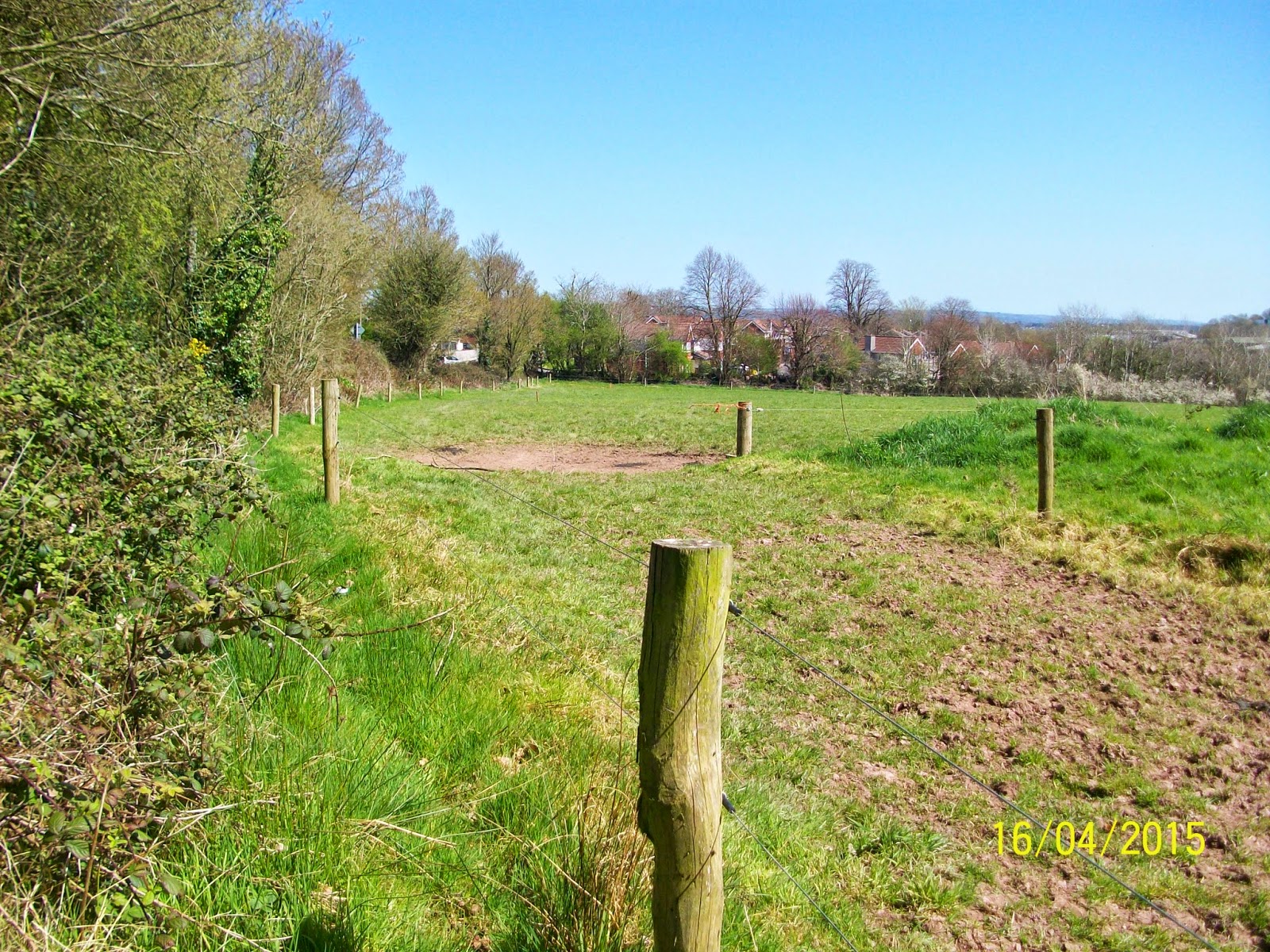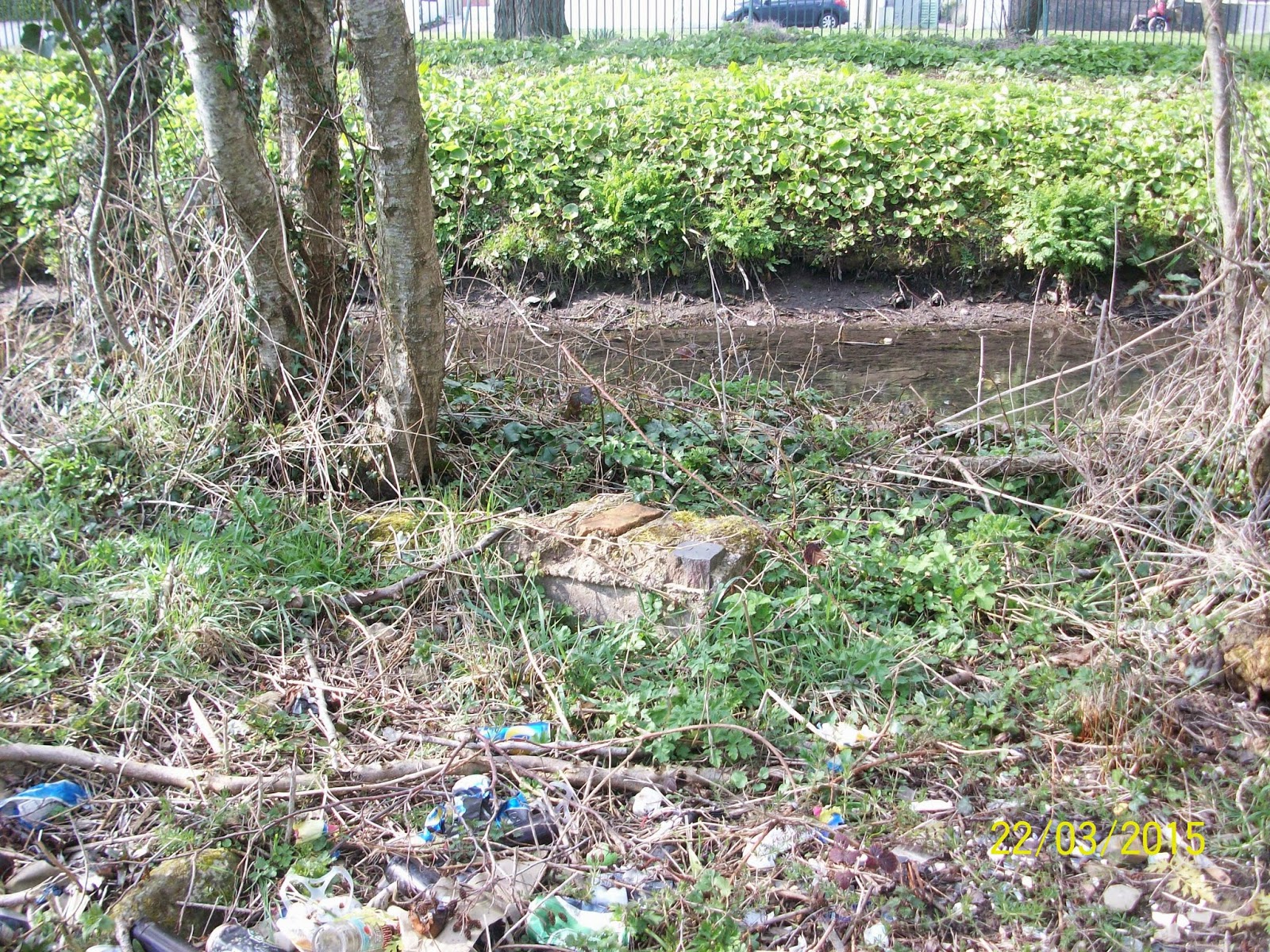View from Wilton Road of Sarsfield Flyover
and Sarsfield Road in the distance
S.M.A. entrance gates from Wilton Road
S.M.A. old side entrance gates from Wilton Rd.
The Fieldwork Trip began with glorious sunshine as Billy O'Brien & Eamonn Pearse made an impromptu pit-stop at Sandbrook Bridge ( under which the Glasheen River flows ) for a quick photo exercise. One item of note came up for discussion ; that of the prevalence of numbered and lettered metal plates on the majority of footbridges found around Togher. The reason for their display is not yet known but is under investigation.
Sandbrook Bridge with numbered plate
( left hand side entrance into Estate )
View of Glasheen River from Sandbrook Bridge
( right hand side of bridge )
View of Glasheen River from Sandbrook Bridge
( left hand side of bridge )
Close up of Glasheen from Sandbrook Bridge
( zoom in of above photo )
( zoom in of above photo )
The Team decided at this juncture to pay a visit to the pedestrian bridge located halfway down the pathway at the rear of the Sarsfield Flyover towards Woodhaven Estate. It is thought that an old metal Railway Foot bridge was sited here in years gone by but no trace could be found. Eamonn recounted how an old oak tree still in situ was used as an impromptu swing by youths in the 1970s from the region. The swing is now long gone but the ancient gnarled tree still stands proudly by the bank of the stream impervious to the passing years. Of particular interest along the stretch of River towards the Sarsfield junction and indeed under it and beyond it were the various flow-through pipes which empty into the River from the former marshland in the near vicinity. Whilst some of the new channels are tastefully decorated and fenced off surrounded by literally 100s of tons of gravel the group was disappointed to see some of the waterway polluted by effluent from sources unknown. Leaving the Sarsfield Flyover behind , mindful of the modern monoliths visible presence in determining Togher's boundary at that point , it was decided to boldly gain access to Sarsfield House in White Oaks Estate.
Concrete bridge near E.S.B Station
and pathway leading to Woodhaven Estate
Concrete pipe leading flow of marshy water into
Glasheen River left of Bridge ( see above photo )
Glasheen River left of Bridge ( see above photo )
Pedestrian concrete footbridge crossing Glasheen
River at right angles heading towards Woodhaven
Underview of concrete footbridge near Woodhaven
Close up of concrete footbridge near Woodhaven
Swing tree on Glasheen River
near Woodhaven Estate
Billy O'Brien near old swing tree
Streamlet flowing under Sarsfield Flyover
towards Glasheen River
Streamlet flowing from marsh off Sarsfield
Road / South Ring Road towards Glasheen River
View of Sarsfield Flyover from Sarsfield Road
View of South Ring Road near Sarsfield Flyover
View of undercarriage of Sarsfield Flyover
with timbered enclosure of streamlet
flowing towards Glasheen River
Railed Streamlet on Sarsfield Road
heading towards Sarsfield Flyover
Billy O'Brien on Sarsfield Road
Start of day-lighted Railed Streamlet
emerging by Sarsfield Road
The former residence of the Sarsfield Family who had a chequered history and association with the people of Togher stretching back Centuries and only ending in 1947 , this building is now occupied by various Financial Institutions who rent out rooms as offices. The group would like to thank the Receptionist for permission to photograph the stairway and stained glass window located just inside the foyer. The house has seen extensive refurbishment as has the glass window which sadly is a replica ( but still affords a unique insight into the houses glory days ) , the original having been vandalized many years previously. Whilst not a faithful reproduction of the Sarsfield Coat Of Arms - the finished work is effective though slightly obscured by the railing in place on the landing , with the Fleur de Lys , the Motto : Virtus Non Vertitur ( Virtue Not Changed ) and the addition of Sarsfield House at the bottom. Above the landing a beautiful porcelain candelabra was sighted - albeit with electric light bulbs - perhaps dating back to the 1920s. Access beyond that point was not available so the Team departed the " White House " and set off for another important House in the Annals of Togher.
Replica stained glass window of
Sarsfield Coat of Arms on landing
inside Sarsfield House
Sarsfield Fleur De Lys in Red and Silver
Close up view of Motto - " Virtue Not Changed "
Titular signage at bottom of stained glass window
Billy O'Brien beside Sarsfield Coat Of Arms
Landing inside refurbished Sarsfield House
Beautifully detailed porcelain candelabra
on ceiling above landing of Sarsfield House
Billy O'Brien on Doughcloyne Bridge
Dirt track on right side of Bridge leading down
towards site of St Bartholomew's Well
Scale of bridge in relation to encroaching
vegetation and tree overgrowth
Earth filled underside of Doughcloyne Bridge
Rubble Arch in contrast to Cut Stone Supports
Opposite side showing Mason craftsmanship
Site of St Bartholomew's Well
View back from Doughcloyne Bridge of old
Bandon trackway showing sole
surviving milestone
Hedge line back from Doughcloyne Bridge
showing proposed Pedestrian Walkway
Streamlet flowing alongside Railway Embankment
Concrete pipe under Railway
Embankment near Fernwood Crescent
Close up of Concrete Pipe under Railway line
View Inside the Pipe!
Billy O'Brien near Liberty Stream by
Fernwood Crescent
Fernwood Crescent
Southwards view of Liberty Stream on its
downward journey from Corcoran's Bridge
Closer view of same shot
Short Video of Liberty Stream near
Fernwood Crescent
Fernwood Crescent
Billy O'Brien by Orchard Walls at Philippine House
After walking from the Glasheen River to the Liberty Stream and taking in some of Togher's historic landmarks , it was decided to call it a day. An exciting foray into the past which is all the more important when the future most certainly holds many surprises which will change the landscape beyond all recognition. The group acknowledged that it is now more than ever , vitally important to archive as much of the region as possible before it is gone forever.















































































